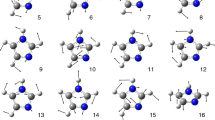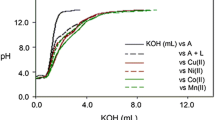Abstract
In an investigation of electronic and ESR spectra, it has been established that titanium(III) with the thiocyanate ion (in ethanol) forms distorted tetrahedral and octahedral complexes. The tetrahedral compounds, which are hydroxo complexes of titanium(III) that contain one hydroxyl group and three thiocyanate ions in the coordination sphere, give signals in the ESR spectra with go=1.960, Ao=15.0·10−4 cm−1 g∥=1.958, A Ti∥ =26.4·10−4cm−1, g= 1.691, ATi=9.0·10−4 cm−1. In the ESR spectra of liquid solutions, additional splitting on the nitrogen atoms is manifested(A No =2.2·10−4 cm−1), which indicates bonding of thiocyanate ions through the nitrogen atom. The pseudo-octahedral complexes of titanium(III), containing from two to six thiocyanate ions in the coordination sphere, are characterized by d-d absorption bands in the 520–590 nm region; and at 77°K, they give anisotropic ESR signals. On the basis of the temperature dependences of the equilibrium constants for the reaction of conversion of the tetrahedral complexes to the octahedral complexes, and also the lifetimes of the tetrahedral complexes, values have been estimated for the heat of reaction (ΔH=26.8 kJ/mole) and the entropy change (ΔS=−1.66 kJ/mole·°K) of the equilibrium process, and also the activation energy for the reaction of titanium(III) thiocyanate formation (ΔE=37 kJ/mole).
Similar content being viewed by others
Literature cited
K. I. Zamaraev and V. N. Parmon. “Possible routes and prospects for the development of photocatalytic solar energy converters,” Usp. Khim.,49, No. 8, 1457–1497 (1980).
A. I. Kryukov, “Electron phototransfer in complex compounds and the initiation of photochemical organic reactions,” Author's Abstract of Candidate's Dissertation, Kiev (1979).
A. I. Kryukov, V. P. Sherstyuk, and I. I. Dilung, Electron Phototransfer and Its Practical Aspects [in Russian], Naukova Dumka, Kiev (1982).
A. N. Golub, Kh. Keler, and V. V. Skopenko (editors), The Chemistry of Pseudohalides [in Russian], Vishcha Shkola, Kiev (1981).
Ya. G. Goroshchenko, The Chemistry of Titanium [in Russian], Naukova Dumka, Kiev (1972).
A. I. Kryukov, A. V. Korzhak, and S. A. Kuchnii, “Photocatalytic formation of hydrogen in alcohol solutions of titanium tetrachloride,” Teor. Éksp. Khim.,20, No. 2, 169–177 (1984).
I. A. Potapov, M. B. Rozenkevich, and Yu. A. Sakharovskii, “Formation of hydrogen in photolysis of aqueous ethanol solutions of Ti(IV),” Koord. Khim.,7, No. 2, 229–231 (1981).
A. Weissberger and E. Proskauer, Organic Solvents, 2nd edn. (revised by J. A. Riddick and E. E. Toops), Wiley-Interscience, New York (1955).
A. I. Kryukov and Z. A. Tkachenko, “Titanium chloride-sensitized photocatalytic liquid-phase oxidation of ethanol,” Dokl. Akad. Nauk SSSR,203, No. 2, 372–375 (1972).
V. A. Tolkachev and A. I. Mlkhailov, “Nomogram for double integration of ESR signal lines,” Prob. Tekh. Éksp., No. 6, 95–96 (1964).
S. Ya. Kuchnii, A. V. Korzhak, and A. I. Kryukov, “Spectroscopic study of state of titanium(III) ions in alcohol-water solutions,” Teor. Éksp. Khim.,19, No. 5, 590–594 (1983).
H. Hartmann, H. L. Schläfer, and K. H. Hansen, “Light absorption by dipolar complexes of titanium(III) of the type [TiA6]3+ with A = H2O, CH3OH, C2H5OH, and (NH2)2CO,” Z. Anorg. Allg. Chem.,289, No. 1/4, 40–65 (1957).
M. C. Day and J. Selbin, Theoretical Inorganic Chemistry, 2nd edn., Reinhold, New York (1969).
N. S. Garif'yanov, E. N. Semenova, and N. F. Usacheva, “Hyperfine structure of ESR lines in liquid solutions of Ti3+, Zh. Strukt. Khim.,3, No. 5, 596–597 (1962).
J. E. Wertz and J. R. Bolton, Electron Spin Resonance, Elementary Theory and Applications, McGraw-Hill, New York (1972).
J. J. Davies and J. E. Wertz, “Trivalent titanium in tetragonal symmetry in MgO and CaO,” J. Magn. Reson.,1, No. 4, 500–508 (1969).
Ya. S. Lebedev and N. N. Tikhomirova, Atlas of ESR Spectra [in Russian], Nauka, Moscow (1964), Part 2.
S. A. Al'tshuler and B. M. Kozyrev, Electron Spin Resonance of Compounds of Intermediate-Group Elements [in Russian], Nauka, Moscow (1972).
R. Wilson and D. Kuvelson, “ESR linewidths in solutions. 1. Experiments on anisotropic and spin-rotational effects,” J. Chem. Phys.,44, No. 1, 154–168 (1966).
A. I. Filippov, “Dependence of line widths of hyperfine structure in liquid solutions of VOCl2 on temperature and pressure,” Zh. Fiz. Khim.,58, No. 10, 2626–2627 (1984).
Ya. I. Tur'yan, “Catalytic polarographic currents of diocyanate complex of titanium(IV). Kinetics of complexation,” Élektrokhimiya,6, No. 7, 961–966 (1970).
G. A. K. Thompson, R. S. Taylor, and A. G. Sykes, “Kinetic studies on the complexing of aquo Ti2+ with thiocyanate, pyrophosphate, and hydrogen fluoride,” Inorg. Chem.,16, No. 11, 2880–2884 (1977).
Author information
Authors and Affiliations
Additional information
Translated from Teoreticheskaya i Éksperimental'naya Khimiya, Vol. 21, No. 5, pp. 560–567, September–October, 1985.
Rights and permissions
About this article
Cite this article
Kuchmii, S.Y., Kulik, S.V., Korzhak, A.V. et al. Electronic and ESR spectroscopic study of thiocyanate-containing coordination compounds of titanium(III) in alcohol solutions. Theor Exp Chem 21, 536–542 (1985). https://doi.org/10.1007/BF00944087
Received:
Issue Date:
DOI: https://doi.org/10.1007/BF00944087




